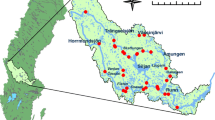Abstract
An optimization-based tool for flow predictions in natural rivers is introduced assuming that some physical characteristics of a river within a spatial-time domain \([x_{\min }, x_{\max }] \times [t_{\min }, t_{\textrm{today}}]\) are known. In particular, it is assumed that the bed elevation and width of the river are known at a finite number of stations in \([x_{\min }, x_{\max }]\) and that the flow-rate at \(x=x_{\min }\) is known for a finite number of time instants in \([t_{\min },t_{\textrm{today}}]\). Using these data, given \(t_{\textrm{future}} > t_{\textrm{today}}\) and a forecast of the flow-rate at \(x=x_{\min }\) and \(t=t_{\textrm{future}}\), a regression-based algorithm informed by partial differential equations produces predictions for all state variables (water elevation, depth, transversal wetted area, and flow-rate) for all \(x \in [x_{\min }, x_{\max }]\) and \(t=t_{\textrm{future}}\). The algorithm proceeds by solving a constrained optimization problem that takes into account the available data and the fulfillment of Saint-Venant equations for one-dimensional channels. The effectiveness of this approach is corroborated with flow predictions of a natural river.







Similar content being viewed by others
Data availability
The datasets generated during and/or analyzed during the current study are available from the corresponding author on reasonable request.
References
Agresta, A., Baioletti, M., Biscarini, C., Caraffini, F., Milani, A., Santucci, V.: Using optimisation meta-heuristics for the roughness estimation problem in river flow analysis. Appl. Sci. 11, 10575 (2021)
Andreani, R., Birgin, E.G., Martínez, J.M., Schuverdt, M.L.: On augmented Lagrangian methods with general lower-level constraints. SIAM J. Optim. 18, 1286–1309 (2008)
Ayvaz, M.T.: A linked simulation-optimization model for simultaneously estimating the Manning’s surface roughness values and their parameter structures in shallow water flows. J. Hydrol. 500, 183–199 (2013)
Askar, M.Kh., Al-jumaily, K.K.: A nonlinear optimization model for estimating Manning’s roughness coefficient. In: Proceedings of the Twelfth International Water Technology Conference, IWTC12, Alexandria, Egypt, 2008, pp. 1299–1306
Birgin, E.G., Martínez, J.M.: Accelerated derivative-free nonlinear least-squares applied to the estimation of Manning coefficients. Comput. Optim. Appl. 81, 689–715 (2022)
Birgin, E.G., Correa, M.R., González-López, V., Martínez, J.M., Rodrigues, D.S.: Randomly supported models for the prediction of flows in channels. (submitted)
Birgin, E.G., Martínez, J.M.: Practical augmented Lagrangian methods for constrained optimization. Society for Industrial and Applied Mathematics, Philadelphia (2014)
Birgin, E.G., Martínez, J.M.: Complexity and performance of an augmented Lagrangian algorithm. Optim. Methods Softw. 35, 885–920 (2020)
Ding, Y., Jia, Y., Wang, S.S.Y.: Identification of Manning’s roughness coefficients in shallow water flows. J. Hydraul. Eng. 130, 501–510 (2004)
Ding, Y., Wang, S.S.Y.: Identification of Manning’s roughness coefficients in channel network using adjoint analysis. Int. J. Comput. Fluid Dyn. 19, 3–13 (2005)
Emmett, W.W., Myrick, W.W., Meade, R.H. Field data describing the movement and storage of sediment in the East Fork River, Wyoming, Part 1. Report No. 1 (River Hydraulics and Sediment Transport, 1979)
Gioia, G., Bombardelli, F.A.: Scaling and similarity in rough channel flows. Phys. Rev. Lett. 88, 014501 (2001)
Guta, K., Prasad, K.S.H.: Estimation of open channel flow parameters by using optimization techniques. Int. J. Sci. Res. 6, 1295–1304 (2018)
Khan, A.A., Lai, W.: Modeling shallow water flows using the discontinuous Galerkin method. CRC Press, Boca Raton (2014)
Marcus, W.A., Roberts, K., Harvey, L., Tackman, G.: An evaluation of methods for estimating Manning’s n in small mountain streams. Mt. Res. Dev. 12, 227–239 (1992)
Meade, R.H., Myrick, W.W., Emmett, W. W. Field data describing the movement and storage of sediment in the East Fork River, Wyoming, Part 2. Report No. 2 (River Hydraulics and Sediment Transport, 1979)
Pappenberger, F., Beven, K., Horrit, M., Blazkova, S.: Uncertainty in the calibration of effective roughness parameters in HEC-RAS using inundation and downstream level observations. J. Hydrol. 302, 46–69 (2005)
Saint-Venant, A.J.C.: Théorie du mouvement non-permanent des eaux, avec application aux crues des rivière at à l’introduction des marées dans leur lit. C. r. Séances Acad. Sci. 73, 147–154 (1871)
Ying, X., Khan, A.A., Wang, S.Y.: Upwind conservative scheme for the Saint-Venant equations. J. Hydraul. Eng. 130, 977–987 (2004)
Funding
This work was supported by FAPESP (grants 2013/07375-0, 2016/01860-1, and 2018/24293-0) and CNPq (grants 302538/2019-4 and 302682/2019-8).
Author information
Authors and Affiliations
Contributions
The two authors of this work worked together and equally in all its stages.
Corresponding author
Ethics declarations
Competing interests
The authors declare no competing interests. Author J. M. Martínez is a member of the journal’s editorial board.
Additional information
Publisher's Note
Springer Nature remains neutral with regard to jurisdictional claims in published maps and institutional affiliations.
Rights and permissions
Springer Nature or its licensor (e.g. a society or other partner) holds exclusive rights to this article under a publishing agreement with the author(s) or other rightsholder(s); author self-archiving of the accepted manuscript version of this article is solely governed by the terms of such publishing agreement and applicable law.
About this article
Cite this article
Birgin, E.G., Martínez, J.M. A PDE-informed optimization algorithm for river flow predictions. Numer Algor 96, 289–304 (2024). https://doi.org/10.1007/s11075-023-01647-1
Received:
Accepted:
Published:
Issue Date:
DOI: https://doi.org/10.1007/s11075-023-01647-1




